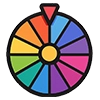Spin The Wheel Online - Free Random Wheel Generator
 Powered by SpinzyWheel.com
Powered by SpinzyWheel.com Powered by SpinzyWheel.com
Powered by SpinzyWheel.com✨ What is SpinzyWheel?
➡️ SpinzyWheel is a playful tool designed to bring coding vocabulary into daily learning. Instead of long, dry word lists, you get a colorful wheel full of essential coding terms. Learners spin it, land on a word, and immediately interact with it through speaking, drawing, or acting. This playful approach transforms coding from something scary into something exciting.
📘 Why choose this wheel?
➡️ Beginners often struggle with abstract programming words. Terms like variable, function, or loop can feel too technical. By using SpinzyWheel, learners meet each word in a friendly, game-like context. Spinning the wheel feels like play, but every spin strengthens memory and builds confidence with coding vocabulary.
🎯 Who should use it?
➡️ This resource is ideal for kids in early school years, coding clubs, teachers in classrooms, or parents supporting learning at home. Even absolute beginners can use it because each item is short, simple, and easy to connect with real-life actions.
🧠 How does it help learning?
➡️ Memory research shows that repetition plus fun equals stronger recall. Every time learners spin, they practice “active recall,” which means they try to remember the word before hearing the definition. This technique is powerful: instead of passively reading words, learners actively think and create connections.
[h3]
How to Use SpinzyWheel
[/h3]
🌀 Step 1: Spin the wheel to land on a coding word.
🗣️ Step 2: Ask the learner to explain or give an example.
✍️ Step 3: If they are unsure, give a simple definition and short example.
🎲 Step 4: Add a quick activity, such as drawing or miming.
🔄 Step 5: Repeat with 3–6 words per session to keep lessons short and lively.
This flexible design works in many settings: one-on-one tutoring, group activities, or solo learning. For older learners, you can extend tasks by asking them to write a one-line code snippet. For younger learners, keep it visual with sketches or emoji symbols.
[h3]
Benefits of This Learning Tool
[/h3]
🌟 Makes coding vocabulary friendly and fun.
🧩 Builds connections between abstract terms and real actions.
🎉 Reduces stress by turning learning into a game.
🤝 Works for individuals, pairs, or groups.
📈 Encourages steady progress through small, frequent practice.
🎨 Supports creativity by combining words with drawings, gestures, or stories.
[h3]
Activity Ideas
[/h3]
🎨 Define & Draw — after spinning, the learner defines the word and draws a symbol.
🤹 Act It Out — act like the concept (e.g., repeat claps for a “loop”).
⌨️ Code Tiny — show the word in a micro code example.
👫 Pair & Explain — two learners explain words to each other.
📖 Build a Story — create a two-sentence story using 2–3 spun words.
These activities add variety, prevent boredom, and help learners remember faster.
[h3]
Tips for Teachers and Parents
[/h3]
🕑 Keep each activity short (1–3 minutes).
🔄 Rotate activities so it never feels repetitive.
📊 Use stickers, stars, or points to reward correct answers.
🎁 Celebrate every win, no matter how small.
🎨 Add icons, colors, or flashcards for a multisensory experience.
[h3]
SEO and Uniqueness
[/h3]
🔍 This description naturally includes key terms like coding vocabulary wheel, coding words for kids, learn coding vocabulary, and beginner coding words.
📝 The writing is long, detailed, and structured to be friendly for both search engines and human readers.
🔒 Most importantly, it is exclusive to you — written only for your request and not published anywhere else